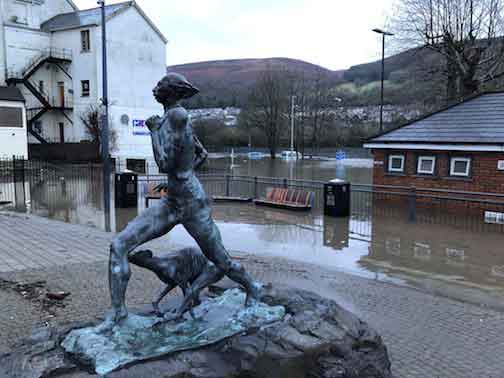Who will be your Hidden Heroine? Cast your vote for the first public statue of a historical Welsh woman in Wales
Which of five historical Welsh women is to be immortalised as the first outdoor public statue of a real woman in Wales is to be decided by the people of Wales. Who will be their ‘Hidden Heroine’?
Two years ago, a group of women came together to address a huge gap in Welsh culture – the fact that there isn’t a single statue of a real Welsh woman anywhere in an outdoor space in Wales.
They created a task force called Monumental Welsh Women to do something about it and started a project pulling together historians, art experts, journalists and business women.
The BBC agreed to support the project and host a public vote and Cardiff City Council welcomed the idea and proposed that the first statue of a historical Welsh woman be placed in the new plaza to be built as part of the development of Central Square where it will be seen by the thousands of visitors and commuters who visit Cardiff every day, as they leave the Central Station. The statue will be partly funded by the Welsh Government.
The shortlist, from which the woman to be represented by the statue will be chosen, has been drawn up by a panel of experts, from a list of 50 historical Welsh women, put together by the Monumental Welsh Women group and the Wales Women’s Equality Network in May last year as part of the celebrations for the Centenary of some women getting the vote. The women on the list epitomised and illustrated the achievements, talents and successes of Welsh women over the years. The five shortlisted were considered by the panel to be great examples of the impact and contribution made by Welsh women across a number of different fields.
The five women shortlisted by the panel are –
Elizabeth Andrews (1882-1960) A Welsh-speaking Rhondda seamstress who left school at 13, Elizabeth became one of the most politically active Welsh women of the early 20th century. This suffragist and miner’s wife put the needs of women and children at the heart of her campaigns. She told the world how mining affected colliers’ families too, fighting for pit-head baths and better housing. She encouraged women to become politically engaged and use their hard-won vote, setting up women’s groups which she called “working women’s universities”. She also became one of Britain’s first female magistrates. And at a time when “domestic issues” were rarely discussed in male-dominated local government, she campaigned for maternity rights, childcare and founded one of the earliest nursery schools in Wales.
Betty Campbell (1935–2017) The child of Butetown who was told by her teacher a working class black girl could never aspire to the academic heights proved her doubters wrong in the most inspirational way. She became Wales’ first headteacher to be a woman of colour and championed her nation’s multicultural heritage throughout her life. No wonder Nelson Mandela sought her out on his only visit to Wales. Her school became a template throughout the UK for good practice in multicultural education while Betty also helped create Black history Month. She continued to influence Welsh life through a series of public appointments, serving as an independent councillor for Butetown, a board member for BBC Wales, a member of the Home Office’s race advisory committee and a member of the Commission for Racial Equality.
Sarah Jane Rees – Cranogwen (1839-1916) Described as “the most outstanding Welsh woman of the 19th century” and known by her bardic name of Cranogwen, Llangrannog-born Sarah Jane Rees excelled in many fields. She was a master mariner, a qualification that allowed her to command a ship in any part of the world. She was a head teacher at 21 and as a poet, she was the first female winner at the National Eisteddfod, a feat that brought her fame across Wales. As a lecturer and preacher, she travelled across Wales and America. As a journalist, she became the first woman to edit a Welsh-language women’s magazine, Y Frythones, which campaigned for girls’ education. And she founded the South Wales Women’s Temperance Union and outlined her vision for homes that rehabilitated homeless young women.
Elaine Morgan (1920-2013) Author, television dramatist and evolutionary theorist, a true Renaissance woman of Wales who excelled in both the arts and science. From the humblest of beginnings in Hopkinstown, Elaine changed the world yet never abandoned her valleys roots. An award-winning scriptwriter she helped create some of the seminal dramas of the 60s, 70s and 80s, from Testament of Youth to The Life and Times of Lloyd George. She brought equality to evolutionary theory with her pioneering book The Descent of Woman – which become a key text in the Women’s liberation movement and saw her feted by the major American feminist thinkers of the day. And Elaine’s advocacy of the Aquatic Ape theory of evolution brought her global recognition. At the age of 89 the Ted Talk she gave on evolutionary theory attracted more than a million viewers.
Margaret Haig Thomas – Lady Rhondda (1883-1958) She may have been a Welshwoman of privilege but Lady Rhondda used that privilege in the best way possible – to fight for the rights of ALL women. She did things few other women of her background would have dared. A suffragette who made the fight for the vote front page news, she was sent to prison where she went on hunger strike. She continued to campaign until all women got the vote in 1928. During World War I, she oversaw the recruitment of women into the services. She was the greatest global businesswoman of her era, sitting on the board of 33 companies and chairing seven of them. She also became the first female to head the Institute of Directors. As a journalist she created a ground-breaking magazine that featured the biggest literary names of the 20th century. And she was the “persistent peeress” whose four decades of campaigning ensured females could finally take their seats in the House of Lords.
Helen Molyneux, one of the Monumental Welsh Women group leading the campaign to erect the statue, says – ‘We are delighted that the BBC is hosting the vote for the statue. Showcasing the achievements of these women on BBC Radio Cymru, BBC Radio Wales and the television evening news programme, Wales Today during the week of the 7th January, is hopefully the start of a much bigger conversation about the role of women in Welsh history and the impact their achievements have had. There is not one single statue of a known historical Welsh woman in Wales and we are hoping that this will be the first of many. ‘
Once the vote has taken place, an artist will be commissioned to implement the statue. There are three world class artists in the running for the commission – Laura Ford, a native of Cardiff, Lucy Orta, and Eve Shepherd. They will each produce concept designs for the statue after the announcement of the winner of the vote and one design will be chosen to take forward to installation on site. The statue is due to be erected in the summer of 2020. The public will be able to cast their vote for their Welsh Hidden Heroin from Friday, January 11 and the vote will close on Wednesday, January 16 with the winner announced live on Wales Today on Friday, January 18. To find out more about the women and for details on how to vote please visit www.bbc.co.uk/HiddenHeroines
BBC Learning have produced educational resources based on the five heroines that are aimed at key stage two teachers. Each teaching pack contains a film, lesson plan and activities for children aged 7-11. The resources give an insight into historical events that took place during their lifetimes and compare them with modern Wales. The content assists with elements of the National Literacy and Numeracy Framework as well as the Digital Competence Framework.
Notes to editors on the background to the project from Helen Molyneux:
The idea for the statue sprang from a conversation with the journalist and broadcaster,
Carolyn Hitt who had written an article about the fact that there are so few statues celebrating the achievements of real women in wales. There are only 2 statues, so far as we know, in Wales: one of Queen Victoria – who was obviously not Welsh – and Boudicca.
Not only are there no statues, but it is actually quite difficult to find the stories of women who have ‘achieved’. Consequently, most people find it difficult to think of anyone worthy of a statue – and therefore assume that there is no one.
The women on our long list of great women who deserve a statue have been described as ‘a bit obscure’. But its precisely because they are obscure – because their achievements weren’t properly recorded or recognised at the time – that we need to bring them to life.
A statue might seem quite an old fashioned way of bringing these women’s histories to wider recognition. But you are a believer in ‘you can’t be what you can’t see’, where are the every -day images of the women who have achieved so much in Wales over the centuries? We have statues of plenty of men but none of women. How can we normalise female success and achievement if we don’t get the same everyday recognition as our male counterparts.
So – the statue project is an extraordinary way of making female success ‘ordinary’ – something not to be commented on as a rare and exotic thing. To give girls – and boys – images of successful, inspiring women that they see as part of the fabric of where they live, because, eventually, to be a successful woman will be nothing noteworthy. We are hoping to keep the project going and have statues of women erected around Wales and hopefully when we have 10 statues of women who have achieved amazing things dotted around Wales, we won’t talk about the fact that they are women, but simply be inspired by their achievements and recognise their contribution to Wales and the world.


